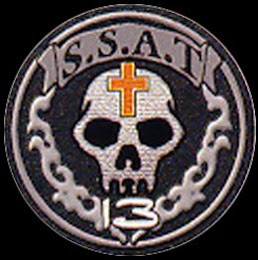These technologies are the basic reasoning for the Universal Century having battle mechs as the main battle unit replacing space fighters.
AMBAC
Active Mass Balance Auto-Control (AMBAC) is a fundamental technology that allows for thrusterless maneuvering in the zero-G environment of space by battle mechs by means of precise movement control of their limbs. The AMBAC technology in conjunction with the fictional fusion reactor developed by the character Dr. Y.T. Minovsky made battle mechs feasible.
Active Mass Balance Auto-Control (AMBAC) is a fundamental technology that allows for thrusterless maneuvering in the zero-G environment of space by battle mechs by means of precise movement control of their limbs. The AMBAC technology in conjunction with the fictional fusion reactor developed by the character Dr. Y.T. Minovsky made battle mechs feasible.
AMBAC works by leveraging Isaac Newton's Third Law of Motion (When there's an action there is an equal and opposite reaction) with regard to inertia to effect changes in direction. For example, if we place a person in a micro-gravity environment where friction is negligible (i.e. space), and ask him to place his left arm to his chest then swing it out to the side, the resulting inertia of the arm movement would result in the rest of his body turning the other direction in order to conserve angular momentum. Then when the motion of the arm stopped, the rotation of the body would also stop. The AMBAC system coordinates movements and micro-movements precisely, allowing a continuous balance and stability without expending reaction mass. For the most part, AMBAC is invisible to the naked eye, as the shifts are slight. However, the system can be used to dodge incoming projectiles or small objects as the arms and legs of a battle mech account for a significant portion of its total mass. The AMBAC system also allows the center of mass to shift outside of the body. AMBAC is by its nature limited to re-orienting the unit about its center of mass, and is not a substitute for propulsion. It is often used in conjunction with the propulsion system to quickly turn the unit and shorten aiming speed as well as directing the main thrusters. The system is similar in principle to the momentum wheel system used in present day satellites, though obviously more complex. Battle mechs performing AMBAC motions would presumably move similarly to present-day astronauts performing extra-vehicular activity: both typically having roughly similar body structure, their use of that mass to control their rotation would presumably be similar, even if calculated by different means.
Tail Binder and Wing Binder
Binders are technological instruments that provide extra control for the AMBAC systems. The idea is simple: "If four limbs can maneuver the unit better than none, why not equip them with 5 or more?" The resulting advancement is the tail binder. The tail binder was originally used as part of the interface for the testing of the concept of transformable mobile units. The tail binder ultimately served as the fifth limb and demonstrated the usefulness of the concept. The unit performed well against more conventional battle mechs and showed superiority in maneuverability.
Binders are technological instruments that provide extra control for the AMBAC systems. The idea is simple: "If four limbs can maneuver the unit better than none, why not equip them with 5 or more?" The resulting advancement is the tail binder. The tail binder was originally used as part of the interface for the testing of the concept of transformable mobile units. The tail binder ultimately served as the fifth limb and demonstrated the usefulness of the concept. The unit performed well against more conventional battle mechs and showed superiority in maneuverability.
A cousin to the tail binder is the wing binder, equipped on most transformable battle mechs with waverider mode as wings. The system made use of the wings' mobility for the transformation during battle mech mode as AMBAC limbs and further increasing the number of limbs for the AMBAC system..
Balancer
A standard piece of battle mech technology, the balancer, sometimes called balance controller or auto-balancer by different authors, is the device responsible for keeping a battle mech upright. This device automatically adjusts to the terrain the battle mech is walking along in. It is the device that enables the machine the ability to walk like a human being. The balancers are placed all across the body of the battle mech's frame, with primary systems being located in the limbs.
Ballute
A technology that allows battle mechs to use balloon like devices called “ballutes” to slow their decent down and prevent burning up when entering the atmosphere of the Earth. However, they are vulnerable to weapon fire, and may burst, causing the Mech to plunge into the atmosphere.
Movable Frame
The movable frame design is a new concept in battle mech construction introduced after the One Year War in anticipation of the increasingly widespread utilization of beam weapons. Before the invention of the concept by engineer Franklin Bidan, all battle mechs' structure were based on a rudimentary internal frame, enclosed within an outer layer of sturdy armor (called the monocoque design). Because a well-placed shot from a beam weapon could easily pierce a battle mech's armor regardless of how thick it is, battle mech designers started to reduce the amount of armor mounted on the battle mechs. This new concept, rather than placing the armor on top of the battle mech's internal mechanism, grafts the armor directly to the frame, thus giving the battle mech the range of joint movement more like that of a human being, at the same time reducing the overall weight. It incorporates all the battle mech's vital mechanisms, thus increasing responsiveness, reliability, and energy efficiency as well as making it far more agile. The first suit to use this system will be the now experimental the RX-178 Nalfeshnee Mk-II and afterwards it is to become the standard in battle mech construction.


No comments:
Post a Comment